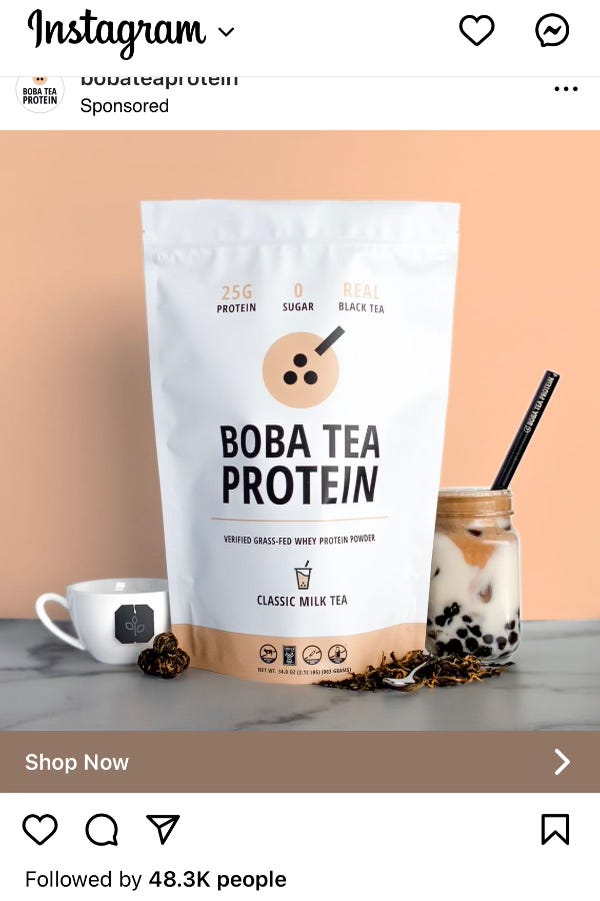What's Good? The Year in Food (Technology)
It's time for my annual review of all things tech, although thank goodness this year you don't have to hear me rant about education. Instead, you get a look at the year in "health" and eating
Welcome to the first annual "Top Trends" series here at Second Breakfast. If you're familiar with my writing on education technology, you know that these annual essays were some of the most popular pieces on Hack Education. My plans with this newsletter include recreating some of that same kind of criticism of the year we've (almost! two more weeks!) survived; but rather than write ten (!) lengthy essays, I'm going to write two shorter ones: one, this week, on food and one, next, on fitness technologies. (I say “shorter,” but Substack tells me this email is actually too long for Gmail, and you might have to click through to the Substack platform to read it in its entirety. Shit. I’m sorry. You know how I get.)
As this is a new newsletter and a new area of research for me, my analysis is pretty tentative, I admit. I'm still very much learning "the beat," just as I'm learning to be an athlete (a runner, a weight-lifter, a swimmer, a cyclist), to be aging, to be sober, to be grieving. (OK, that one, I have pretty fucking dialed in.) So, as I wrote in the first newsletter back in March, consider this a “soft launch.” It takes some time to understand the signals of an industry, to be able to listen to the stories it tells, to understand the broader culture narratives, and to evaluate what's really going on. Writing my weekly round-up of the news and these annual reviews has always helped me do so.
In addition to being an athlete, I'm a cook. I'm an eater. I love food. And while there is a link between nutrition and health, I'm still not totally sure that I have a good grasp on how I want to frame the ways in which food technology and fitness technology and wellness technology all work in concert. I'm still just as likely to bookmark stories that interest me personally — histories of breakfast cereals, sure, and stories that conjure 70s/80s food nostalgia (Casa Bonita! It's back!) — as I am to pick up on the stories I'm supposed to care about. Supposed to care about per industry marketing. Per mainstream journalism. Per influencers. Per the, you know, gestalt.
Back in August, The New York Times listed “5 Wellness Trends to Watch,” arguing that "a few clear themes have emerged over the first half of the year." I'm still not certain, four months later, that there are clear themes or that the ones the paper picked out are the ones to watch. I mean, yes, for sure Ozempic (Trend 1) is everywhere in the news. Not only are we obsessed with weight-loss (our own, sure, but mostly others'), we are increasingly obsessed with consuming protein (Trend 5) as a way to stay “lean”; and we're taking a helluva lot of other supplements too (Trend 3), many of which have absolutely no scientific backing. "Therapy" is another wellness trend (Trend 4) according to The NYT at least (and it does appear that more Americans are seeking mental health treatment), as are saunas (Trend 2).
Wait, what? Saunas? That one was totally not on my radar, and in the months that followed the publication of this list, I still have seen no evidence this is A Big Thing in wellness. I have seen no TikToks, no Instagram videos, no People or Us Weekly stories about saunas; I've had no Internet recommendations from friends; Anne Helen Petersen hasn't written about it, so is it even a thing? Granted, I'm (still) not tuned into the world of "bro science" podcasting — Andrew Huberman and Joe Rogan and such — and maybe that's where all the sauna-chat happens. I don't know. (I do know I'll have more to say about bro science when I turn to my analysis of fitness tech next week.)
But going back through my notes from the year and all the "what's good" newsletters I've sent you on Fridays, I'm not sure that this list from The New York Times get things right — not for wellness at large, and not for the food and nutrition part of the equation. Even protein and supplements — something I have written about quite a bit here on Second Breakfast — don't really dominate the media coverage as much as I thought. Supplements are a multi-billion dollar industry, for sure, but I wonder if it's my attention to protein as an athlete that gave them weight in my framework (and in turn — thanks algorithms! — in my feed, making me see a lot of protein-related advertising).

The cultural narrative about food and health is really complex, with all sorts of financial, political, and (for lack of a better word) moral interests at play — farmers, ranchers, manufacturers, transporters, sellers, restauranteurs, obviously, but also doctors, pharmaceutical companies, politicians, parents, and on and on and on. (Related, a recommended read: The Meth Lunches by Kim Foster1.) If you look closely, you can see how certain stories just stick. (You can see how industries try very very hard to make certain stories stick.) You can see how certain stories fail to.
There are only three macronutrients after all, and as we cycle through their demonization — first fats, now carbs — we're really only left with protein to hype, I suppose.
Plus, protein is what makes The Rock so swole, we're told. (I would have guessed it’s resistance training). Its consumption is bound up in masculinity, and strangely intertwined — and has been for over a century — not just in fitness and wellness circles but with fascists and white nationalists (not to mention there was the whole hot-dog-entrepreneur angle to the attempted coup in Russia this summer).
Of course, unless you're following some weird meat-only diet, much of what we're sold as protein probably still contains sugar. The ubiquitous "protein bar" is, let's be honest, just a candy bar with modern marketing. (When you think about it, most foods are candy bars with modern marketing — this is the whole snack industry, right?) And surely that's another trend: foods are constantly being rebranded as "healthy" — your soda is now medicinal; it's a tonic, a guard against aging and disease.
Under the guise of protein promotion, folks were desperately desperately desperately trying to get us to eat cottage cheese this year. "It's high in protein!" we were told. "And it has less sugar than yogurt!" (Is the push to make cottage cheese cool again related to the decline in milk consumption by younger people — an attempt, by Big Milk to remain relevant as we increasingly turn to non-dairy substitutes? IDK.)
Ironically, despite all the handwringing and fear-mongering we heard this year about sugar this year, but increasingly about "ultra-processed foods" — their supposed correlation with obesity, cancer, and depression, for example — many of the things we were told we should be eating "for our health" (and/or for the health of the planet) were also (LOL) highly processed foods. Protein powders, obviously. Fake meat (lab-grown meat was approved by the Department of Agriculture for sale this year incidentally, but the fake meat industry is having a rough go of things despite all the pro-protein hoopla). All that non-dairy milk is processed too, obviously. Regular ol' milk too — pasteurized, fortified, etc.
The definition of "ultra-processed foods" is murky, at best. Almost every single thing we eat is processed in some way. Did you put salt on it? It's now a processed food. Did you cook it? Processed. Did it come in a package? Processed. That's not to say that there aren't substantial drawbacks to a diet of highly-processed foods — particularly the kinds of hyper-palatable treats that dominate so much of our food environment, from our local grocery store and bodega shelves to our nearby restaurant menus (fast food, fast casual, and otherwise). But it’s not as easy as telling people to “make better choices” when a lot of this stuff is, quite literally, subsidized by the government. And frankly, the call that we cook everything from scratch is some reactionary, chauvinist bullshit.
Much of what we eat for breakfast — this is, ostensibly, a newsletter about breakfast after all — is processed food, from the little-bit-processed (say, steel-cut oats) to ultra-super-duper-processed (say, Beyond Meat’s breakfast sausage). Breakfast has long been a meal that's served with a side-dish of moralizing, from the early days of breakfast cereal on (See: “When Corn Flakes Were Part of an Anti-Masturbation Crusade”). So it's no surprise that it's a meal that gets people worked up into a frenzy when others do it "wrong" somehow. (And I admit, I try to be pretty neutral about what other people eat, but I do scrunch up my face worriedly when I hear people boast that they don't eat breakfast at all.)
Perhaps because everyone is up-in-arms about sugar/carbs, even cereal had a tough 2023, as sales of the breakfast staple fell. (Tony the Tiger also enraged right-wingers briefly by posing for a photo with trans activist Dylvan Mulvaney.) "It's the Breakfast of Champions No More: Cereal Is in Long-Term Decline," The Wall Street Journal pronounced in September. A good headline, no doubt, beaten only by The Financial Times that called health conscious consumers “cereal killers.”
Magic Spoon, a venture-backed company, hoped to benefit from this supposed turn away from carbs with its protein-heavy cereal (made from whey protein powder) — I reviewed it here — and was successful in a lot of glowing media coverage, including a weird claim in The New York Times last week that having an "instagrammable design" like the cereal company's space in SoHo is going to lure young workers back to the office. Hahahahahahahaha. No.
Interestingly, it may well be the return to the office (and to school and to all manner of in person gatherings post-pandemic) that's contributing to the cereal industry's struggles. We're all back to moving quickly to get up and out the door in the mornings, many of us opting, instead of a bowl of corn and milk to start the day, for a fast food sandwich that we can eat with one hand, in the car — and hey, more protein, right?
A side note: the cereal industry, the fast food industry, hell the whole food industry invest heavily in what The New Yorker, in its fascinating look this spring at the development of the Taco Bell Crunchwrap, calls "stunt food." Stunt foods are items designed not for their longevity — products that we make a part of our regular, long-term purchasing/consumption — but rather for their ephemerality, their novelty, their shock-value, and their appeal on social media. This year we saw Kit Kat cereal. Icee cereal. Fruity Pebbles waffles. Eggo Waffles liqueur. And on and on and on. The next time someone tries to tell you that technology innovation is amazing, think of pancake-flavored Cup o' Noodles, smile politely, and walk away.
This appeal of “stunt food” on social media is important as "influencers" — fitness influencers, diet influencers, wellness influencers, and the like — churn out a lot of content about food (sometimes paid for by the food/beverage industry): "what I eat in a day" videos; how to turn two or three ingredients (often including protein powder) into a brownie or a gluten-free bread item or the like; how to hide vegetables in muffins or spaghetti sauce; walks through the grocery store where the ingredients on items are read aloud to the camera then denounced as bad/toxic/glucose-spiking/unhealthy/banned in Europe; "girl dinner”; and such. Short videos are an ideal medium for food (and cooking) content, according to The New York Times at least. They're also ideal for misinformation, anti-fat bias, and disordered eating. Fun.
Some breakfast-industry analysts argued this year that cereal has simply become too expensive; fast food, for all its drawbacks, remains cheap and convenient. Indeed, an op-ed in a West Virginia paper suggested that the rising price of cereal will be what costs Joe Biden the upcoming election. (Not the right’s embrace of authoritarianism and anti-democratic practices.) The Wall Street Journal, ever sensitive to these sorts of economic issues, suggested in January that if eggs were too expensive, "maybe you should skip breakfast."
One more likely culprit for the rising price of food: capitalism. Or at least, private equity funds that bought up a lot of food companies before the markets crashed in 2022. (Of course, the business media is also trying to tell us that the reason that people are buying less food is not that it's too damn expensive: because of Ozempic, we're eating less. FFS.) Surely consolidation in the grocery store industry doesn't help things; nor does the industry’s domination by a few big companies (cough cough Amazon, even though Amazon seems to suck at groceries).
The response, across almost all industries, to the demand for better wages and affordable food and housing has been to ramp up the ol’ canard that robots are coming. (Apologies to those who believe the talk about the marvels of ChatGPT is really about the marvels of ChatGPT and not about the capital class hoping to cut labor costs and block unionization.) Food growers and food makers and restauranteurs are still trying to convince us they can replace workers with robots. And it's a cute gimmick. Right up until your chatbot starts promoting anorexia or creates recipes using poison.
One of the things that's so striking to me in this new writing endeavor is how we frame health — and that includes food and fitness and their respective technologies — as a matter of individual choice. The pathway to health that's prioritized and privileged in our storytelling is one of consumerism. (And, arguably its twin, entrepreneurialism. See Virginia Sole-Smith on Michelle Obama's launch of a "healthy food for kids" company.) Markets will fix everything, we're told — and even that's a bit more collectivist than the narrative often allows. Because "health" is not framed as a communal concern as much as a personal one. It's rarely framed as a political matter as much as a lifestyle issue.
This has huge implications for food, of course, as we face global climate change — had trouble getting sriracha this year? Yeah. Exactly. Markets aren’t really going to work out the growing conditions for hot peppers. We have to unwind long legacies of imperialism that have made our food technologies and food practices grossly exploitative and unethical. (Another book recommendation: Alicia Kennedy’s No Meat Required.)
I've written 3000 words here, and I haven't addressed Ozempic at all, which is no doubt one of the biggest stories of the year when it comes to wellness technology — food and fitness and otherwise. We can see in the stories about Ozempic all the overhyped promise that comes with any "new" product that certain industries think is going to be wildly lucrative. (Change the definition of obesity so that more people are obese? Profit.) We can see too, throughout all the Ozempic chatter, how weight is framed as individual responsibility — that is, as a fat person's failure to be thin and not as society's dangerous discrimination against people in larger bodies and not as the myriad of structural inequalities that many people face, inequalities that are tied to abysmal food environments and abysmal health outcomes. To be clear, this is not a matter of individual choice; this is a matter of social policy. Drugs like Ozempic "are blockbusters," sociologist Tressie McMillan Cottom writes, "because they promise to solve a medical problem that is also a cultural problem — how to cure the moral crisis of fat bodies that refuse to get and stay thin."
Food technologies — the stories about food and the practices about food and the ideologies about food — are also cultural problems that can be medical problems. We simply aren't going to shop or gadget our way to food justice, let alone to health and well-being for all.
Affiliate link. Proceeds from the sale of any books go to Marcus Books in Oakland, California — the country’s oldest independent, Black-owned bookstore. ↩





